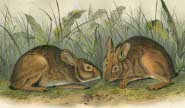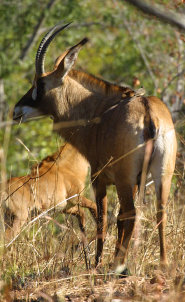Monday 25 August 2014
Tapeti - a Cottontail friend

The Tapeti (
Sylvilagus brasiliensis), otherwise known as a forest rabbit are found in countries including; Argentina, Brazil, Belize, Bolivia, Honduras, Mexico, Venezuela, Peru and Panama. When full grown, these mammals can be anywhere from 9-17 inches (22-43 cm) long. They weigh about 1.5 - 2.2 lbs (0.7 - 1 Kgs) and can live up to three years. Although males are usually a bit smaller than the females the two genders are pretty comparable. This species has very short ears, short legs and a dark body and tail. These forest rabbits are capable of breeding all year round. Luckily these forest rabbits are in the low risk category for being an endangered animal.
The tapeti is very active all year round and you will usually find them hopping about. They are usually most active in the daylight hours. There have been several reports that this rabbit is capable of swimming. When parenting, the mother digs a nest about 5 inches deep and plucks off her own fur to put inside the nest to keep her young warm. The young feed off of their mother only once a day for less than five minutes. Although the mother does not go inside of the nest, she sits on top of the nest for her young to feed off of her. The male tapeti is not involved in caring for the young, but will help attack an enemy if approached.
When a predator approaches this animal it is capable of staying completely still for longer than 10 minutes if necessary. If they are approached when they are with their young then this species may attack using their nails. Fox, coyotes and large birds such as falcons, eagles and condors are predators to the tapeti. Just like any other rabbit, forest rabbits enjoy green weeds and grass. When food is scarce in the forest these animals may eat bark off of trees and small shrubs to make it through the season. In cooler countries this species may only be able to live off of bark and then would be known as a wood vegetarian. This beautiful species is greatly known for their ability to get as large as they do, and their beautiful coat that they develop as adults.
You can help spreading the word about this animal by liking it on facebook
Permanent Link
Friday 08 August 2014
Roan Antelope - Goat- and Horse-like Antelope of Africa

The roan antelope (Hippotragus equinus) appears as if evolution somehow crossed a goat and a horse to produce one of the most common large antelope species found in Central African countries such as Nigeria and Ghana. Both bulls and cows have the cloven hooves and beards of goats, but the long legs and short striped mane of a zebra. They get their common name from roan a color of domesticated horse (Equus caballus.) In horses, roan is a mixture of white hairs plus a base color. In the roan antelope, the colors are vivid white, brown and black.
Domesticated horses did not arrive in Africa until European and Middle Eastern conquerors brought them there. The Linnaean system of taxonomy is based on European perceptions. Since many African countries were colonized by the French, many Africans call the roan antelope “la Antelope Chevaline,” or “horse-like antelope.” Taxonomists and biologists are unsure if the ran antelope has more than one subspecies.
General Description
Roan antelopes have goat-like heads with a broad forehead tapering to a small muzzle. They have long, rabbit-like ears with white insides and dark edges. Their body confirmation is similar to a horse and has a tail and stiff, upright mane like a zebra. Their main coloration is a light brown with a dark dorsal stripe down the back. Their muzzles, hindquarters around the tail and circles around the eyes are white. Bulls have mahogany brown to black heads.
Both bulls and does grow black long, curving horns, but bulls grow longer horns than do does. Bull horns also sport prominent ridges, while doe horns are smoother. Bulls are taller than females. At the highest point of their shoulders, bulls average 4.62 feet (1.4 meters) and females average 4.29 feet (1.3 meters.) Both sexes weigh in at an average of 594 pounds (270 kilograms.) They may not sound like prizefighters, but adult roan antelopes have been known to kill adult lions.
Life Cycle and Behavior
Roan antelopes live in herds similar to wild horses. One dominant male protects a small harem of six to ten females and their offspring. Once bull calves reach sexual maturity at two to three years old, the dominant bull drives them away so they will not compete for breeding rights. This also helps to keep from inbreeding. Although fierce, the roan antelope’s main weapon is their speed. They can gallop up to 35 miles (56.3 kilometers) per hour. Sadly, their speed is no match for a hunter’s gun. The species is being poached for meat and for the spectacular horns.
Bulls rarely fight for supremacy of a herd, but when they do they fight so fiercely that serious injuries or deaths can occur. They clash their horns but also kneel on ground to deliver painful bites. Adults breed year round if food is plentiful. Cows carry their calves for nine months. They usually bear a single calf because a mother cannot produce enough milk to support two calves. With luck, they can live to be 18 years old.
Picture of the Roan antelope by Paul Maritz, licensed under
GFDL
You can help spreading the word about this animal by liking it on facebook
Permanent Link
 The Tapeti (Sylvilagus brasiliensis), otherwise known as a forest rabbit are found in countries including; Argentina, Brazil, Belize, Bolivia, Honduras, Mexico, Venezuela, Peru and Panama. When full grown, these mammals can be anywhere from 9-17 inches (22-43 cm) long. They weigh about 1.5 - 2.2 lbs (0.7 - 1 Kgs) and can live up to three years. Although males are usually a bit smaller than the females the two genders are pretty comparable. This species has very short ears, short legs and a dark body and tail. These forest rabbits are capable of breeding all year round. Luckily these forest rabbits are in the low risk category for being an endangered animal.
The Tapeti (Sylvilagus brasiliensis), otherwise known as a forest rabbit are found in countries including; Argentina, Brazil, Belize, Bolivia, Honduras, Mexico, Venezuela, Peru and Panama. When full grown, these mammals can be anywhere from 9-17 inches (22-43 cm) long. They weigh about 1.5 - 2.2 lbs (0.7 - 1 Kgs) and can live up to three years. Although males are usually a bit smaller than the females the two genders are pretty comparable. This species has very short ears, short legs and a dark body and tail. These forest rabbits are capable of breeding all year round. Luckily these forest rabbits are in the low risk category for being an endangered animal.
 The roan antelope (Hippotragus equinus) appears as if evolution somehow crossed a goat and a horse to produce one of the most common large antelope species found in Central African countries such as Nigeria and Ghana. Both bulls and cows have the cloven hooves and beards of goats, but the long legs and short striped mane of a zebra. They get their common name from roan a color of domesticated horse (Equus caballus.) In horses, roan is a mixture of white hairs plus a base color. In the roan antelope, the colors are vivid white, brown and black.
The roan antelope (Hippotragus equinus) appears as if evolution somehow crossed a goat and a horse to produce one of the most common large antelope species found in Central African countries such as Nigeria and Ghana. Both bulls and cows have the cloven hooves and beards of goats, but the long legs and short striped mane of a zebra. They get their common name from roan a color of domesticated horse (Equus caballus.) In horses, roan is a mixture of white hairs plus a base color. In the roan antelope, the colors are vivid white, brown and black.